Are you excited to explore Morocco but unsure what to pack? Morocco is known for its rich culture and varied landscapes. From Marrakech’s busy streets to the calm Sahara Desert, knowing what to bring is key for a great trip.
As you get ready, think about the basics for a successful Moroccan adventure. This practical guide will cover the essentials. You’ll learn what to pack for different places, ensuring a comfortable and fun journey.
Key Takeaways
- Understand the cultural and environmental nuances of Morocco
- Pack essentials that cater to diverse landscapes
- Learn how to prepare for a comfortable journey
- Discover the must-have items for your Moroccan adventure
- Get tips on navigating different environments with ease
Understanding Morocco’s Diverse Climate
Planning your trip to Morocco means understanding its climate. It changes a lot from one place to another. Whether you’re by the coast, in the desert, or in the mountains, you need to plan carefully.
Coastal Regions: Mediterranean Influences
The coastal areas of Morocco feel the Mediterranean’s touch. This brings mild temperatures and moderate humidity.
Temperature Ranges by Month
Coastal areas stay between 50°F to 75°F all year. This makes them perfect for tourists. Knowing the temperature by month helps you pack right.
Humidity and Wind Considerations
Coastal regions have moderate humidity. Sea breezes help cool things down in the summer.
Desert Areas: Extreme Temperature Variations
The desert in Morocco sees huge temperature swings.
Day vs. Night Temperature Differences
Daytime in the desert can be very hot. But nights get cold quickly. You’ll need layers and warm clothing to stay comfortable.
Seasonal Sandstorm Preparation
Visiting the desert means being ready for sandstorms. Wear masks and goggles to protect yourself.
Mountain Regions: Cooler Temperatures Year-Round
The mountains in Morocco stay cooler all year. Temperatures drop as you go higher.
Altitude Effects on Weather
Going up in altitude makes it cooler. Wearing layers is key for mountain hikes.
Unexpected Weather Patterns
Watch out for sudden rain or snow in the mountains. Being prepared is important for your adventures.
Seasonal Packing Considerations
Morocco’s climate changes with the seasons. Knowing what to pack depends on when you go. Whether you’re in the cities, mountains, or countryside, being prepared is key.
Winter (November-February): Layers and Warmth
Winters in Morocco can get quite cold, especially in the mornings and evenings. It’s important to pack layers for comfort.
Essential Cold Weather Items
Don’t forget warm clothes like fleeces, sweaters, and a waterproof jacket. Thermal underwear is also a good idea for chilly mornings and nights.
Rain Preparation for Northern Regions
The north of Morocco gets more rain in winter. A sturdy umbrella and waterproof shoes will help you stay dry.
Spring (March-May): Moderate Temperatures
Spring is a great time to see Morocco, with mild weather everywhere.
Transitional Clothing Strategies
Choose clothes that can be layered. You’ll need lightweight pants, long-sleeved shirts, and a light jacket.
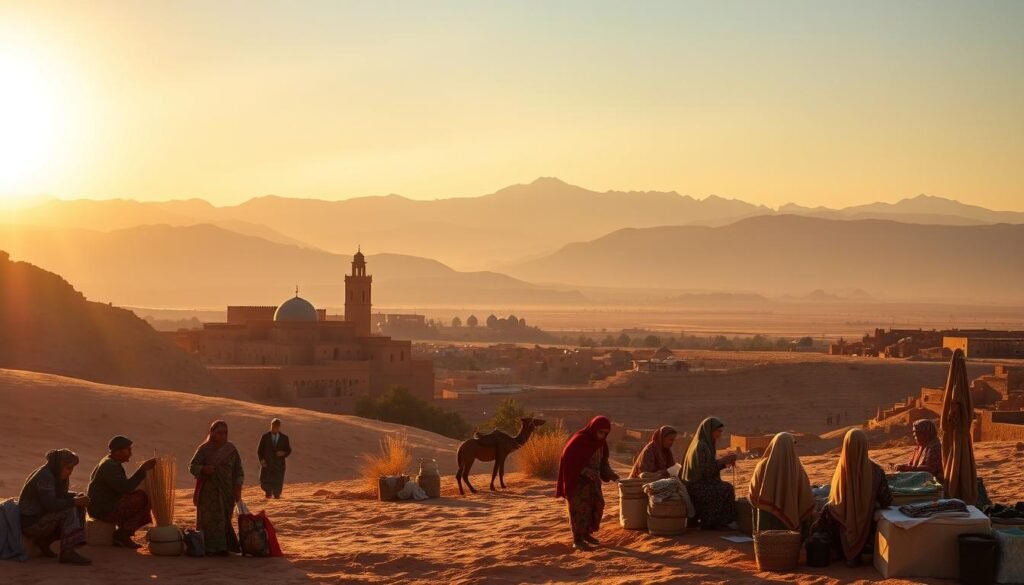
Summer (June-August): Heat Protection
Summer in Morocco is very hot, especially in the desert.
Lightweight Fabrics and Options
Opt for light, breathable fabrics like cotton and linen. Wear loose clothes to stay cool.
Hydration Solutions
It’s important to drink lots of water. Bring a refillable bottle and consider electrolyte drinks.
Fall (September-October): Transitional Weather
Fall in Morocco is perfect, with comfortable temperatures.
Versatile Packing Approaches
Pack layers like in spring. Include short and long-sleeved shirts, lightweight pants, and a sweater or light jacket.
| Season | Weather | Packing Essentials |
|---|---|---|
| Winter | Cold, potential rain | Layers, waterproof jacket, warm clothing |
| Spring | Mild temperatures | Layered clothing, light pants, long-sleeved shirts |
| Summer | Hot, especially in deserts | Lightweight, breathable fabrics, hydration solutions |
| Fall | Comfortable temperatures | Layered clothing, mix of short and long-sleeved shirts |
By thinking about these seasonal tips, you’ll be ready for your Morocco trip, no matter when you go.
Essential Clothing Items
To explore Morocco well, pack clothes that are modest and comfy. Morocco values modesty, so dressing right is key, especially at religious sites or in rural areas.
Modest Attire for Cultural Respect
Wearing modest clothes is about respect, comfort, and fitting in. Both men and women should wear clothes that cover shoulders and knees.
Women’s Clothing Considerations
Women should wear loose, body-covering clothes. A scarf is handy for covering shoulders or hair when needed.
Men’s Clothing Considerations
Men should also dress modestly. Avoid shorts and sleeveless shirts, especially in rural areas or mosques.
Breathable Fabrics for Comfort
Choose breathable fabrics for comfort in Morocco’s different climates. The right fabric makes a big difference.
Natural vs. Synthetic Materials
Natural fabrics like cotton and linen are great for hot weather. Synthetic materials are good for active travelers because they wick away moisture.
| Fabric Type | Benefits | Best For |
|---|---|---|
| Cotton | Breathable, natural | Casual wear |
| Linen | Cooling, absorbent | Hot weather |
| Synthetic | Moisture-wicking | Active wear |
Versatile Pieces for Different Settings
Pack versatile clothes that work for day and night, or casual and formal settings. This makes packing more efficient.
Day-to-Night Transition Items
Choose items that can be mixed and matched for different occasions.
Upscale Dining and Special Occasions
For fancy dinners or special events, bring a few formal outfits that still respect local modesty.
« The way you dress can significantly impact your experience in Morocco. Dressing modestly and comfortably allows you to enjoy the culture without drawing unnecessary attention. »
Footwear for Various Terrains
Morocco’s landscapes are diverse, and so is the footwear you’ll need. Whether you’re in the cities, desert, or mountains, the right shoes are key.
City Exploration: Comfortable Walking Shoes
Walking in Morocco’s cities requires comfortable shoes. Choose ones that are both comfy and culturally fitting.
Medina Navigation Footwear
In medinas, shoes that are easy to remove are handy. This is especially true when visiting mosques or homes.
Desert Excursions: Sturdy Sandals and Boots
Desert trips need shoes that protect from sand and heat. Sandals with a good grip are best to avoid slipping.
Sand-Friendly Options
Choose sandals or boots that breathe. A closed-toe design adds extra protection from the elements.
Mountain Treks: Hiking Boots
For mountain hikes, boots with ankle support and traction are vital. Make sure they’re waterproof and have a rugged sole.
Ankle Support and Traction Features
Boots with high ankle support prevent injuries. Look for ones with advanced traction for slippery paths.
| Terrain | Recommended Footwear | Key Features |
|---|---|---|
| City | Comfortable Walking Shoes | Comfort, Cultural Appropriateness |
| Desert | Sturdy Sandals/Boots | Protection from Sand, Breathability |
| Mountain | Hiking Boots | Ankle Support, Traction |
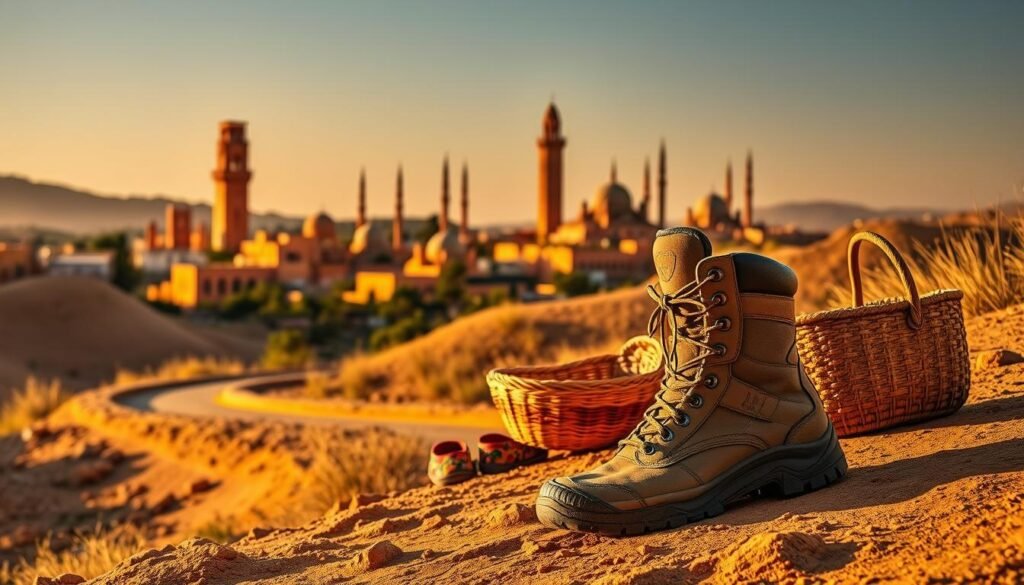
Sun Protection Essentials
Morocco’s sun is very strong, so you need to pack sun protection essentials. As you visit markets, cities, and deserts, keeping your skin safe is key. This makes your trip more comfortable and fun.
High-SPF Sunscreen
High-SPF sunscreen is a must-have. It protects your skin from harmful UVB rays. This helps prevent sunburn and skin damage. Choose a high SPF and apply it well to your face and body.
Face vs. Body Protection
Use the same sunscreen for face and body, but pick a gentle face formula. This avoids clogged pores. For your body, a stronger formula offers better protection.
Hats and Sunglasses
Hats and sunglasses are also crucial for sun protection. A wide-brimmed hat protects your face, neck, and ears. Sunglasses keep your eyes and skin safe.
Styles That Offer Maximum Coverage
Choose hats with a 3-inch brim for best coverage. For sunglasses, pick styles that cover your face or have big lenses. This protects your eyes from all sides.
Lightweight Coverings
Scarves and wraps offer extra skin protection and style. They can cover your shoulders or head and neck.
Multi-Purpose Scarves and Wraps
Scarves and wraps are great for many uses. They can be a blanket, picnic mat, or a fancy dinner accessory.
With these sun protection items, you’re ready to enjoy Morocco’s beauty and culture. You’ll avoid the discomfort of sunburn.
Health and Hygiene Kit
It’s important to pack a health and hygiene kit for a trip to Morocco. A good kit helps you stay healthy and comfortable in different places and cultures.
Medications and First Aid
Make sure you have all your medications and a first-aid kit. This is key for a safe trip.
- Prescription Medications: Bring enough for your whole trip, along with your prescription and a doctor’s note.
- Over-the-Counter Essentials: Pack pain relievers, antihistamines, and antacids, among other things.
Prescription Medications
Keep your prescription medications in their original packaging. This helps avoid problems at customs or airport security.
Over-the-Counter Essentials
It’s a good idea to have over-the-counter medications like pain relievers and antacids. Bring a small amount of what you usually use.
Stomach Remedies for Food Adjustments
Trying new foods and water can upset your stomach. Having stomach remedies on hand can help.
Preventative Options
Think about bringing anti-diarrheal medication. It can help with any stomach problems during your trip.
Personal Hygiene Products
Personal hygiene products are crucial for staying healthy and comfortable while traveling.
Hard-to-Find Items in Morocco
Some personal hygiene items might be hard to find in Morocco. Pack any specific toiletries or sanitary products you need.
Preparing a good health and hygiene kit makes your trip to Morocco better. Don’t forget to check the expiration dates of your medications and supplies before you go.
Technology and Documentation
Morocco is waiting for you, but first, let’s talk about the tech and documents you’ll need. Staying connected and having the right documents are key to a smooth trip in Morocco.
Travel Adapters and Chargers
First, make sure you have the right travel adapters for Morocco. The country uses Type C and E sockets, with a standard voltage of 220V and a frequency of 50Hz. A universal travel adapter will keep your devices charged.
Morocco-Specific Plug Types
Morocco’s plugs are different from many countries. Type C plugs have two pins and are ungrounded. Type E plugs also have two pins and are grounded. Get a travel adapter that fits these types.
Important Documents and Copies
Have all your documents ready before heading to Morocco. Make sure your passport is valid for at least six months after your trip. If needed, get a visa in advance. Also, make photocopies of your passport, visa, and travel insurance.
Digital and Physical Backup Strategies
Make digital copies of your important documents and store them online safely. You can also leave a copy with someone you trust back home. This way, you can access your documents if they’re lost or stolen.
Money and Payment Options
Knowing your money and payment options is crucial in Morocco. Credit cards are accepted in tourist areas, but cash is preferred in smaller towns and markets.
Cash vs. Card Considerations
It’s wise to carry both cash and cards. Tell your bank about your travel plans to avoid account issues.
| Payment Method | Acceptance in Morocco | Precautions |
|---|---|---|
| Cash | Widely accepted, especially in traditional markets | Be mindful of counterfeit bills; have small denominations |
| Credit/Debit Cards | Accepted in tourist areas and larger cities | Inform your bank of travel plans; have a backup card |
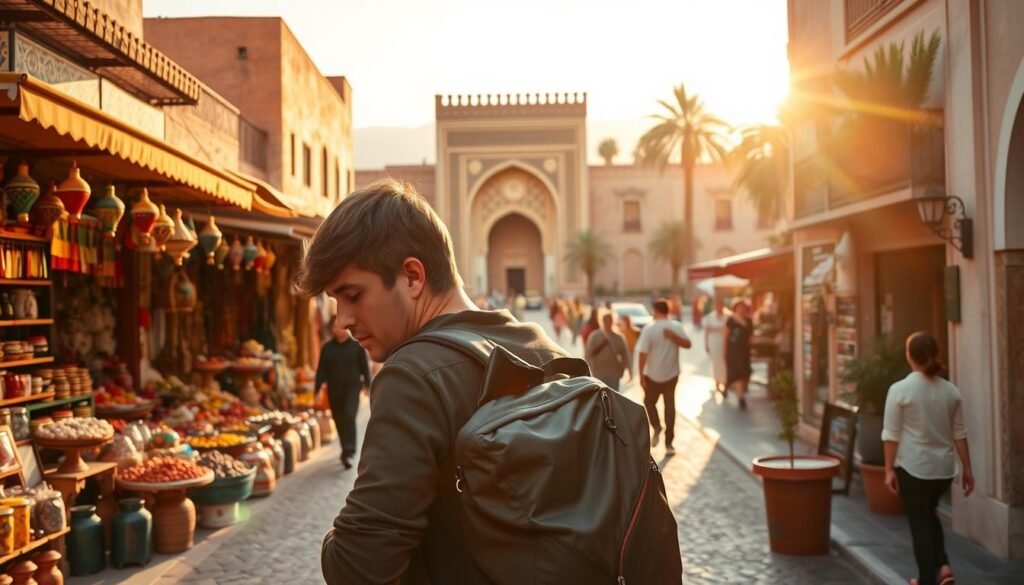
Practical Guide for Morocco: Cultural Considerations
To really get into Morocco’s lively culture, you need to know the local customs. Understanding and showing respect for these norms will make your trip better. It also helps you connect well with the Moroccan people.
Respecting Local Customs Through Dress
Dressing modestly shows respect, especially at religious sites or rural areas. Morocco is conservative, so it’s best to cover your shoulders and knees. In cities and tourist spots, the dress code is a bit more relaxed. Still, dressing modestly helps avoid unwanted attention.
Religious Sites and Rural Areas
At mosques or rural villages, dress conservatively. Women, wear a scarf to cover your hair as a sign of respect. Removing your shoes before entering a mosque is also a common practice.
Urban vs. Tourist Areas
In cities like Marrakech and Fez, you’ll see both traditional and modern clothes. While tourist areas are more relaxed, dressing modestly is still valued by locals.
Gift-Giving Etiquette
Gift-giving is big in Moroccan culture. Bringing gifts like dates, sweets, or tea when visiting a Moroccan home is polite. Learning a few Arabic phrases to say thank you is also a nice touch.
Appropriate Items to Bring from Home
Think about bringing gifts that show your culture or country. A unique item or specialty food is always appreciated.
Communication Tools and Phrases
Learning basic Arabic and French phrases helps a lot. Use language apps or translation resources to improve your interactions.
Language Apps and Translation Resources
Google Translate is very useful. Also, knowing basic phrases like « hello » (as-salamu alaykum) and « thank you » (shukraan) is greatly appreciated.
Essential Arabic and French Phrases
Some key phrases are « hello » (as-salamu alaykum), « thank you » (shukraan), and « goodbye » (ma’a as-salaama). Knowing these can help you in everyday conversations.
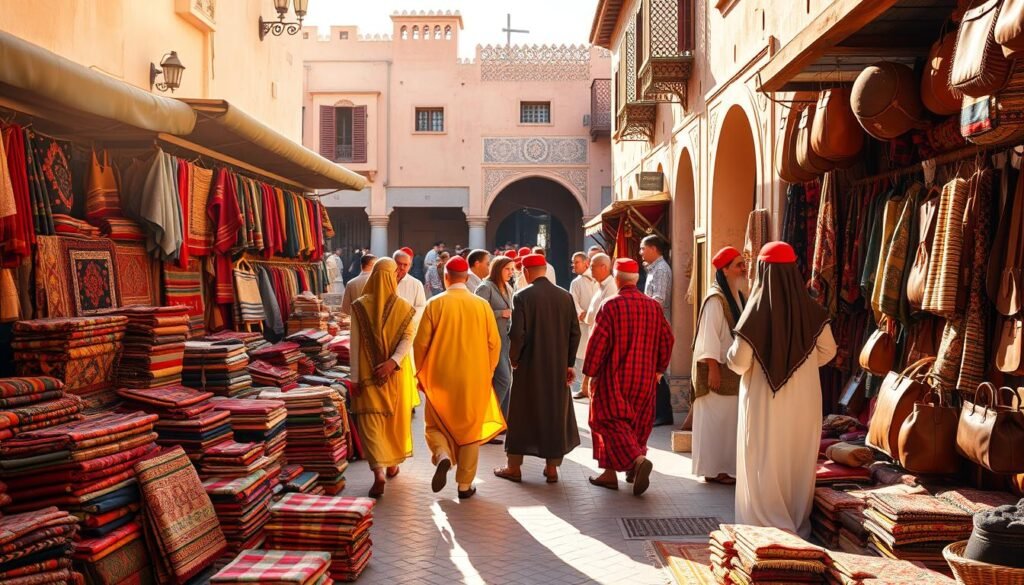
Activity-Specific Gear
To explore Morocco efficiently, you need the right gear for each activity. Morocco has a lot to offer, like camel trekking, desert camping, hammam visits, and cooking classes.
Camel Trekking and Desert Camping
For camel trekking and desert camping, comfort is essential. Wear comfortable clothing and bring a sleeping bag for the desert’s cold.
Comfort Items for Overnight Stays
Take a portable mattress or sleeping pad for better sleep in the desert.
Hammam Visits
At a hammam, you’ll need the right bathing clothes. A swimsuit or modest wear is best.
Appropriate Bathing Attire
Remember a towel and extra clothes for after your hammam visit.
Photography Equipment
Photography lovers should protect their gear from sand and weather. Use a protective case and lens cleaning cloth.
Protection from Sand and Elements
A camera rain cover or protective bag is handy in tough weather.
| Activity | Essential Gear |
|---|---|
| Camel Trekking | Comfortable clothing, Sleeping bag |
| Hammam Visits | Swimsuit, Towel |
| Photography | Protective case, Lens cleaning cloth |
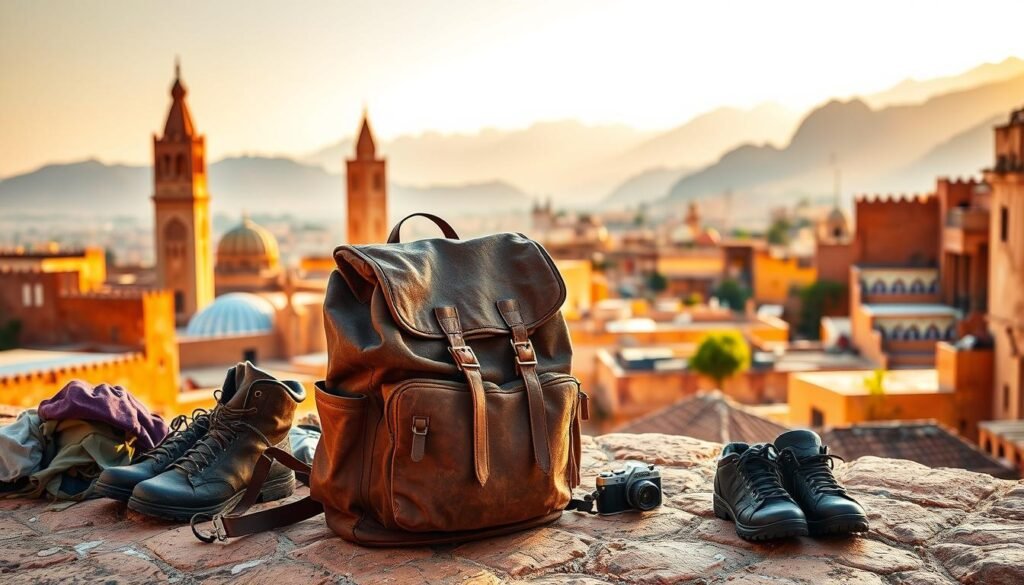
Packing the right gear lets you fully enjoy Morocco’s varied activities. Your trip will be memorable.
What Not to Pack
Knowing what not to pack for Morocco can make your trip easier. It’s as important to know what to leave behind as what to bring.
Unnecessary Items That Take Up Space
Morocco has a good tourist setup, so you can buy many things when you get there. You don’t need to pack a lot of toiletries because they’re easy to find.
Readily Available Local Alternatives
You can find local items instead of packing them. For example, hammams provide toiletries, and markets have personal care products. This lets you pack lighter and buy what you need when you arrive.
Culturally Inappropriate Items
It’s important to respect Morocco’s culture. Some clothes can be seen as offensive, especially in rural areas or mosques.
Clothing to Avoid
Don’t pack clothes that are too revealing or casual. Women should avoid short shorts and tank tops. Men should wear modest clothes, like long pants and shirts with sleeves, in mosques or rural places.
Overpackaging Pitfalls
Travelers often pack too much because of laundry worries. But, Morocco has many laundry services, especially in big cities and tourist spots.
Laundry Options During Your Stay
Many riads and hotels offer laundry services. You can also find public laundromats in places like Marrakech and Fez. So, you can pack lightly, knowing laundry services are available.
Shopping in Morocco: What to Leave Room For
Traveling to Morocco means you should have extra space for shopping. The country is known for its lively markets and souks. Here, you can find unique, handmade items that show off Morocco’s rich culture.
Artisanal Crafts and Souvenirs
Morocco is known for its ceramics and metalwork. These items are perfect souvenirs and a great way to remember your trip. You can find them in markets like Marrakech’s busy souks.
Ceramics and Metalwork
Moroccan ceramics and metalwork are loved for their detailed designs and skill. You can find everything from decorative tiles to stunning jewelry.
Textiles and Carpets
Textiles and carpets are also popular in Morocco. They range from colorful fabrics to detailed carpets. These items are not just beautiful but also show Morocco’s long textile history.
Packing and Shipping Options
For big items like carpets, think about how to get them home. Many shops offer packing and shipping services. This makes it easier to transport your finds.
Spices and Food Items
Morocco is famous for its spices and tasty food products. You can find a variety of spices and condiments. They’re great for adding a Moroccan touch to your cooking.
Customs Considerations
When buying food items, know the customs regulations for bringing them home. This helps avoid any problems when you return.
By leaving extra space in your luggage, you can take home some of Morocco’s unique finds. This makes your trip even more special.
Conclusion: Packing Smart for an Unforgettable Moroccan Adventure
Getting ready for Morocco? Packing smart is crucial for a memorable trip. This guide helps you deal with Morocco’s weather, respect local ways, and enjoy your time here.
Morocco is full of exciting places, from busy medinas to peaceful deserts. With these tips, you’ll be ready for your adventure. You’ll get to experience Morocco’s rich culture.
When planning your trip, don’t forget the basics. Pack modest clothes, sun protection, and a health kit. With these, you’re set to explore Morocco’s cities, mountains, and deserts. Happy travels, and have a great time in Morocco!





